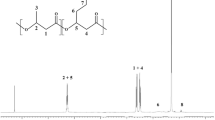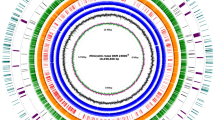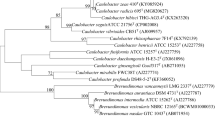Abstract
A novel polyhydroxyalkanoate (PHA)-producing bacterium, Jeongeupia sp. USM3 (JCM 19920) was isolated from the limestone soil at Gua Tempurung, Perak, Malaysia. This is the first report on the complete genome sequence for the genus Jeongeupia. This genome consists of a circular chromosome with a size of 3,788,814 bp and contains 3557 genes. Two PHA synthase (phaC) genes encoding for the key enzyme in the polymerization of PHA monomers and other PHA-associated genes were identified from the genome. Phylogenetic analysis of the PhaC protein sequences has revealed that both PhaC1 and PhaC2 of Jeongeupia sp. USM3 are categorized as Class I PHA synthases with 56% similarity to each other. Both of the PHA synthase genes of this isolate were cloned and heterologously expressed in a PHA mutant strain Cupriavidus necator PHB−4. The ability of the transformants to accumulate PHA showed that both PhaC1 and PhaC2 were functional.



Similar content being viewed by others
References
Bhubalan K, Yong KH, Kam YC, Sudesh K (2010) Cloning and expression of the PHA synthase gene from a locally isolated Chromobacterium sp. USM2. Malays J Microbiol 6:81–90
Braunegg G, Sonnleitner BY, Lafferty RM (1978) A rapid gas chromatographic method for the determination of poly-β-hydroxybutyric acid in microbial biomass. Eur J Appl Microbiol Biotechnol 6:29–37
Budde CF, Riedel SL, Willis LB, Rha C, Sinskey AJ (2011) Production of poly (3-hydroxybutyrate-co-3-hydroxyhexanoate) from plant oil by engineered Ralstonia eutropha strains. Appl Environ Microbiol 77:2847–2854
Carpa R, Butiuc-Keul A, Lupan I, Barbu-Tudoran L, Muntean V, Dobrotă C (2012) Poly-β-hydroxybutyrate accumulation in bacterial consortia from different environments. Can J Microbiol 58:660–667
Cevallos MA, Encarnacion S, Leija A, Mora Y, Mora J (1996) Genetic and physiological characterization of a Rhizobium etli mutant strain unable to synthesize poly-beta-hydroxybutyrate. J Bacteriol 178:1646–1654
Chee JY, Yoga SS, Lau NS, Ling SC, Abed RMM, Sudesh K (2010) Bacterially produced polyhydroxyalkanoate (PHA): converting renewable resources into bioplastics. Curr Res Technol Educ Topics Appl Microbiol Microb Biotechnol 2:1395–1404
Chek MF, Kim SY, Mori T, Arsad H, Samian MR, Sudesh K, Hakoshima T (2017) Structure of polyhydroxyalkanoate (PHA) synthase PhaC from Chromobacterium sp USM2, producing biodegradable plastics. Sci Rep 7:5312
Chen GQ, Wu Q (2005) The application of polyhydroxyalkanoates as tissue engineering materials. Biomaterials 26:6565–6578
Chen WM, Chang RC, Cheng CY, Shiau YW, Sheu SY (2013) Jeongeupia chitinilytica sp. nov., a chitinolytic bacterium isolated from soil. Int J Syst Evol Microbiol 63:934–938
Chin CS, Alexander DH, Marks P, Klammer AA, Drake J, Heiner C, Clum A, Copeland A, Huddleston J, Eichler EE, Turner SW, Korlach J (2013) Nonhybrid, finished microbial genome assemblies from long-read SMRT sequencing data. Nat Methods 10:563
Demirdöğen RE, Emen FM, Ocakoglu K, Murugan P, Sudesh K, Avşar G (2018) Green nanotechnology for synthesis and characterization of poly (3-hydroxybutyrate-co-3-hydroxyhexanoate) nanoparticles for sustained bortezomib release using supercritical CO2 assisted particle formation combined with electrodeposition. Int J Biol Macromol 107:436–445
Doi Y, Kitamura S, Abe H (1995) Microbial synthesis and characterization of poly (3-hydroxybutyrate-co-3-hydroxyhexanoate). Macromolecules 28:4822-4828.
Foong CP, Lau NS, Deguchi S, Toyofuku T, Taylor TD, Sudesh K, Matsui M (2014) Whole genome amplification approach reveals novel polyhydroxyalkanoate synthases (PhaCs) from Japan Trench and Nankai Trough seawater. BMC Microbiol 14:318
Foong CP, Lakshmanan M, Abe H, Taylor TD, Foong SY, Sudesh K (2018) A novel and wide substrate specific polyhydroxyalkanoate (PHA) synthase from unculturable bacteria found in mangrove soil. J Polym Res 25:23
Friedrich B, Hogrefe C, Schlegel HG (1981) Naturally occurring genetic transfer of hydrogen-oxidizing ability between strains of Alcaligenes eutrophus. J Bacteriol 147:198–205
Hong JW, Song HS, Moon YM, Hong YG, Bhatia SK, Jung HR, Choi TR, Yang SY, Park HY, Choi YK, Yang YH (2019) Polyhydroxybutyrate production in halophilic marine bacteria Vibrio proteolyticus isolated from the Korean peninsula. Bioprocess Biosyst Eng 42:603–610
Kim J, Kim YJ, Choi SY, Lee SY, Kim KJ (2017) Crystal structure of Ralstonia eutropha polyhydroxyalkanoate synthase C-terminal domain and reaction mechanisms. Biotechnol J 12:1600648
Kolibachuk D, Miller A, Dennis D (1999) Cloning, molecular analysis, and sxpression of the polyhydroxyalkanoic acid synthase (phaC) gene from Chromobacterium violaceum. Appl Environ Microbiol 65:3561–3565
Kovach ME, Elzer PH, Hill DS, Robertson GT, Farris MA, Roop RM II, Peterson KM (1995) Four new derivatives of the broad-host-range cloning vector pBBR1MCS, carrying different antibiotic-resistance cassettes. Gene 166:175–176
Kundrat V, Cernekova N, Kovalcik A, Enev V, Marova I (2019) Drug release kinetics of electrospun PHB meshes. Materials 12:1924
Lok C (2015) Mining the microbial dark matter. Nat News 522:270
Maehara A, Ueda S, Nakano H, Yamane T (1999) Analyses of a polyhydroxyalkanoic acid granule-associated 16-kilodalton protein and its putative regulator in the pha locus of Paracoccus denitrificans. J Bacteriol 181:2914–2921
Mandon K, Michel-Reydellet N, Encarnación S, Kaminski PA, Leija A, Cevallos MA, Elmerich C, Mora J (1998) Poly-β-hydroxybutyrate turnover in Azorhizobium caulinodans is required for growth and affects nifA expression. J Bacteriol 180:5070–5076
Ng LM, Sudesh K (2016) Identification of a new polyhydroxyalkanoate (PHA) producer Aquitalea sp. USM4 (JCM 19919) and characterization of its PHA synthase. J Biosci Bioeng 122:550–557
Peoples OP, Sinskey AJ (1989) Poly-beta-hydroxybutyrate (PHB) biosynthesis in Alcaligenes eutrophus H16. Identification and characterization of the PHB polymerase gene (phbC). J Biol Chem 264:15298–15303
Pohlmann A, Fricke WF, Reinecke F, Kusian B, Liesegang H, Cramm R, Eitinger T, Ewering C, Pötter M, Schwartz E, Strittmatter A, Voß I, Gottschalk G, Steinbüchel A, Friedrich B, Bowien B (2006) Genome sequence of the bioplastic-producing “Knallgas” bacterium Ralstonia eutropha H16. Nat Biotechnol 24:1257
Raberg M, Voigt B, Hecker M, Steinbüchel A (2014) A closer look on the polyhydroxybutyrate-(PHB-) negative phenotype of Ralstonia eutropha PHBˉ4. PLoS ONE ONE 9:e95907
Rehm BHA (2003) Polyester synthases: natural catalysts for plastics. Biochemical Journal 376:15–33
Rehm BHA, Steinbüchel A (1999) Biochemical and genetic analysis of PHA synthases and other proteins required for PHA synthesis. Int J Biol Macromol 25:3–19
Schlegel HG, Lafferty R, Krauss I (1970) Bacterial mutants of Hydrogenomonas lacking poly-β-hydroxybutyric acid. Experientia 26:554–555
Schlegel HG, Lafferty R, Krauss I (1970) The isolation of mutants not accumulating poly-β-hydroxybutyric acid. Archiv für Mikrobiologie 71:283–294
Schubert P, Steinbüchel A, Schlegel HG (1988) Cloning of the Alcaligenes eutrophus genes for synthesis of poly-beta-hydroxybutyric acid (PHB) and synthesis of PHB in Escherichia coli. J Bacteriol 170:5837–5847
Shah AA, Hasan F, Hameed A, Ahmed S (2008) Biological degradation of plastics: a comprehensive review. Biotechnol Adv 26:246–265
Simon R, Priefer U, Pühler A (1983) A broad host range mobilization system for in vivo genetic engineering: transposon mutagenesis in gram negative bacteria. Nat Biotechnol 1:784
Slater SC, Voige WH, Dennis DE (1988) Cloning and expression in Escherichia coli of the Alcaligenes eutrophus H16 poly-beta-hydroxybutyrate biosynthetic pathway. J Bacteriol 170:4431–4436
Tai YT, Foong CP, Najimudin N, Sudesh K (2016) Discovery of a new polyhydroxyalkanoate synthase from limestone soil through metagenomic approach. J Biosci Bioeng 121:355–364
Tan GYA, Chen CL, Li L, Ge L, Wang L, Razaad IMN, Li Y, Zhao L, Mo Y, Wang JY (2014) Start a research on biopolymer polyhydroxyalkanoate (PHA): a review. Polymers 6:706–754
Tombolini R, Povolo S, Buson A, Squartini A, Nuti MP (1995) Poly-β-hydroxybutyrate (PHB) biosynthetic genes in Rhizobium meliloti 41. Microbiology 141:2553–2559
Valentin HE, Steinbüchel A (1993) Cloning and characterization of the Methylobacterium extorquens polyhydroxyalkanoic-acid-synthase structural gene. Appl Microbiol Biotechnol 39:309–317
Wang Z, Itoh Y, Hosaka Y, Kobayashi I, Nakano Y, Maeda I, Umeda F, Yamakawa J, Kawase M, Yag K (2003) Novel transdermal drug delivery system with polyhydroxyalkanoate and starburst polyamidoamine dendrimer. J Biosci Bioeng 95:541–543
Wei DX, Dao JW, Chen GQ (2018) A micro-ark for cells: highly open porous polyhydroxyalkanoate icrospheres as injectable scaffolds for tissue regeneration. Adv Mater 30:1802273
Wittenborn EC, Jost M, Wei Y, Stubbe J, Drennan CL (2016) Structure of the catalytic domain of the class I polyhydroxybutyrate synthase from Cupriavidus necator. J Biol Chem 291:25264–25277
Yoon JH, Choi JH, Kang SJ, Choi NS, Lee JS, Song JJ (2010) Jeongeupia naejangsanensis gen. nov., sp. nov., a cellulose-degrading bacterium isolated from forest soil from Naejang Mountain in Korea. Int J Syst Evol Microbiol 60:615–619
Zinn M, Witholt B, Egli T (2001) Occurrence, synthesis and medical application of bacterial polyhydroxyalkanoate. Adv Drug Deliv Rev 53:5–21
Acknowledgements
This work was supported by USM-RIKEN International Centre for Aging Science (URICAS) (1001/PBIOLOGI/870033). N.-A.A.Z. is grateful to the Public Service Department of Malaysia scholarship scheme. Authors thank Hui Pheng Kho for her contribution in experimental works and Dr. Todd Taylor (RIKEN, Japan) for his useful advice.
Author information
Authors and Affiliations
Corresponding author
Ethics declarations
Conflict of interest
The authors declare that they have no conflict of interest.
Additional information
Publisher's Note
Springer Nature remains neutral with regard to jurisdictional claims in published maps and institutional affiliations.
Electronic supplementary material
Below is the link to the electronic supplementary material.
Rights and permissions
About this article
Cite this article
Zain, NA.A., Ng, LM., Foong, C.P. et al. Complete Genome Sequence of a Novel Polyhydroxyalkanoate (PHA) Producer, Jeongeupia sp. USM3 (JCM 19920) and Characterization of Its PHA Synthases. Curr Microbiol 77, 500–508 (2020). https://doi.org/10.1007/s00284-019-01852-z
Received:
Accepted:
Published:
Issue Date:
DOI: https://doi.org/10.1007/s00284-019-01852-z




